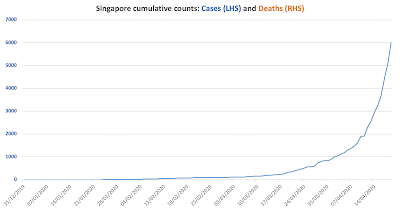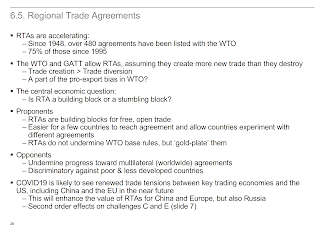The madness of Oil (see an explainer below):
An explainer:
Quite a number of folks - including journalists - have confused the above data and the 'reported' price of oil today for the actual price of oil. It is not as simple as that. Actual price of oil did not fall below zero, though for some grades it has been below zero before and is still staying there now. So what all of this really means?
Q1: Is price of oil below zero? The answer is "it depends on what price of oil one takes". Let me explain.
First, there are several major grades of oil. The two most popular are:
- Brent North Sea Crude (commonly known as Brent Crude). Brent originates in Brent oil fields and other sites in the North Sea. Brent is a benchmark price for African, European, and Middle Eastern crude oil producers, covering, roughly two-thirds of the world's crude oil production.
- West Texas Intermediate (commonly known as WTI) and this is a benchmark oil for North America.
- Urals grade oil is Russian oil
- Fateh grade oil or Dubai Fateh is the most important crude oil benchmark for Asia
- Iran Heavy and Iran Light are benchmarks for Iranian oil.
The percentage of sulfur in crude oil varies across the grades and fields of extraction, and this percentage basically determines the amount of processing required to refine oil into energy products. "Sweet crude" is a term that refers to crude oil that has less than 1% sulfur: Brent at 0.37% and WTI at 0.24%. And both Brent and WTI are "sweet". So, "sweet" oils carry a market premium, as refineries can process these at lower cost.
Fateh sulphur content is around 2%, Urals at 1.35%, and other grades are described here: https://en.wikipedia.org/wiki/List_of_crude_oil_products. Higher sulphur content oil trades at a discount on WTI - or used to, roughly, prior to 2008 GFC. Since GFC, U.S. supply of WTI oil has been growing more robustly than Brent supply, so the relationship reversed (see chart below).
Now, notice the above table also shows "Port of Sale". This is an important feature of trading and pricing of oil and it matters in today's oil price determination too. Bear with me.
So, let's focus on WTI and Brent.
- Brent is traded at a discount on WTI because it is harder to process
- WTI is traded in the futures markets - with contracts signed and priced today for future delivery. The NYMEX (New York Mercantile Exchange) division of the CME (Chicago Mercantile Exchange) trades futures contracts of WTI. Physical delivery for WTI futures occurs in Cushing, Oklahoma. Futures are contracts that must be delivered in physical delivery if held to maturity. In other words, futures are NOT options. Options can be left to expire and the bearer does not have to take a delivery of the commodity on which the option is written. With futures, if you bough June 2020 delivery of oil contract for 1,000 barrels at, say $22, and you hold it to expiration (at the end of May 2020), you will have to take physical delivery of 1,000 barrels of oil in Cushing, OK, no matter what.
- Brent crude oil futures trade on the Intercontinental Exchange (ICE), and are traded with delivery internationally. In other words, Brent futures contracts are deliverable to specific country, not to one location globally, as is the case with WTI.
If you opt for (1), you will need somewhere to store 1,000 barrels and a transport from Cushing, OK to wherever that storage facility is. Both cost money. And, worse, the former is not available, since we are experiencing a glut of oil. You can pay to store your oil on board transport - e.g. on board a tanker sitting in the Gulf of Mexico, or on-board railroad cars. This is hellishly expensive, even if you own the said tanker or railroad cars. So you will not do this. Worse, yet, there is so much crude out there in storage already, that short-of-demand refineries are not buying oil today. Which means you will be paying high costs of storing this stuff for weeks to come.
If you opt for (2), you need a buyer of the contract that can do (1). And these are not available, because everyone is short storage and everyone is facing a market with no buyers for this stuff for weeks.
So you dump your May futures contracts at a negative price just to get rid of the obligation to take physical delivery of oil in May. And this is exactly what happened today with May futures (charts above) for WTI.
Now, the same did not happen today in the Brent markets. Why? Because Brent, as noted above, is deliverable across a number of countries, not just Cushing, OK. Which means you can shift location of delivery to find a more-likely-available storage facility for it, or a more-ready-to-buy refinery. In chart 2 above, top red line did not fall as much today - these are Brent futures for May contracts.
Here is the spot price of oil for Brent and WTI:
And here it is over the last year:
Today's prices are not in the chart. So here they are:
Observe negative prices on some lower quality (high sulphur - ugly) stuff in the above. These are down to the lack of refineries willing to take low quality crude when there is a glut of higher quality key stuff available. And note that Brent is nowhere near $0 today.
Blend of WTI and Brent is another way to look at oil prices. And here is a table from the CME showing different month contracts for the blend:
Yes, may delivery is ugly. June and on, however, is well above $20 per barrel.






















































